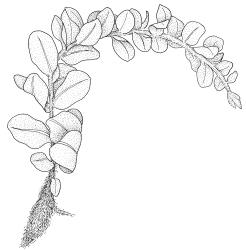Elements in the following description are taken from McIntosh (2014).
Plants mostly robust (as in N.Z. species) or sometimes small, rarely dendroid, forming tufts or mats, green or with secondary pigmentation. Stems mostly unbranched, erect, arching, or stoloniferous (as in N.Z. species), in cross-section with a well-developed central strand, beset with pigmented, papillose or rarely smooth and often dimorphic rhizoids. Leaves mostly crowded near stem apices and more distant below, distributed spirally on the stem but sometimes distichous on sterile shoots, often forming rosettes around terminal gametangia, broad, variable in shape (± elliptic in N.Z. species) and mostly rounded apically, usually bordered and toothed, mostly contorted when dry, often ± decurrent. Upper laminal cells mostly rounded-hexagonal, firm- or thin-walled, nearly always smooth, collenchymatous or not, irregularly arranged or sometimes in rows; marginal cells mostly differentiated to form a distinct, mostly 1–2 layered border; alar cells not differentiated. Costae single and strong, ending well below apex to subpercurrent (as in N.Z. species), to excurrent, in cross-section variable in structure. Gemmae (including tubers) lacking.
Sexuality variable (dioicous in N.Z. species). Perichaetia terminal, usually surrounded by a rosette of leaves. Perigonia terminal if present. Setae single or multiple, variable in colour, elongate, smooth; capsules horizontal to pendent, subglobose to obovoid (in N.Z. species) to cylindric, mostly with a weakly differentiated neck; stomata restricted to neck or distributed on urn, immersed; annulus usually differentiated; operculum variable. Peristome double and well-developed; exostome teeth 16, mostly lanceolate-acuminate; endostome from a high basal membrane, with well-developed and often perforate segments (rarely fused apically) and nodulose cilia. Calyptra cucullate, smooth. Spores spherical.
The family is considered by McIntosh (2014) to consist of 12 genera and 92 species worldwide. It is nearly cosmopolitan but is most diverse in temperate and cooler regions of the northern hemisphere. A single species of the genus Plagiomnium is well-documented in N.Z. A second, unidentified species is very poorly known here. The allied genus Orthomnion Wilson occurs in tropical Australia.
The classification of the Mniaceae and its allied families has been the object of much attention in recent years, but no consensus concerning the familial limits has been achieved. Brotherus (1924) considered the family to consist of seven genera. His concept of the genus Mnium Hedw. was very broad and several assemblages, sometimes recognised by Brotherus as sections, have been subsequently segregated and raised to the generic level.
A very broad concept of the Mniaceae was advocated by Goffinet et al. (2009). In their concept, several genera traditionally placed in the Bryaceae (Pohlia, Epipterygium, and Mielichhoferia, as well as Schizymenium) were included in the Mniaceae, largely on the basis of molecular data published by Cox & Hedderson (2003). However, the inclusion of these genera in a family centred around Mnium Hedw. resulted in a morphologically extremely heterogeneous and unsatisfactory assemblage, and their concept is therefore not followed here.
The circumscription of the Mniaceae for the Australian flora that was employed by Wyatt & Ramsay (2012) excluded the four genera cited in the previous paragraph, and is accepted here. Their concept of the family was, in turn, influenced by Shaw’s placement of these same genera in their own family, the Mielichhoferiaceae, in the Flora of North America (Shaw 2014, as outlined in an earlier online version by Shaw). Wyatt & Ramsay’s concept of the Mniaceae thus accords with the concept of that family employed by McIntosh (2014) for North America, although the North American representatives are far more diverse. According to Wyatt & Ramsay (2012) the removal of Pohlia, Epipterygium, Mielichhoferia, and Schizymenium from the Mniaceae accounts for recent molecular evidence from "nuclear, chloroplast, and mitochondrial genomes [that] suggests that a broad Mniaceae clade may have separated early into two diverging lineages, the families Mielichhoferiaceae and Mniaceae."
Koponen has published extensively over many years on the classification of the Mniaceae in its traditional sense and he also erected the genus Plagiomnium. Koponen’s (1968) initial generic revision of the Mniaceae stressed, among other morphological features, stem branching patterns, stem anatomy, rhizoid morphology and topography, leaf areolation, border and costal anatomy, and the presence or absence of secondary pigments.
At a later date, Koponen (1988) suggested that Plagiomnium, Orthomnion, and Pseudobryum (Kindb.) T.J.Kop. be isolated into their own family (Plagiomniaceae), and that some genera traditionally placed in the Rhizogoniaceae might be better placed in a reduced Mniaceae, together with Mnium s.s. Koponen’s (1988) proposals are not followed here.
| Category | Number |
|---|---|
| Indigenous (Non-endemic) | 1 |
| Total | 1 |




